HDZ Official Rules Out Scrapping COVID Passes
ZAGREB, 8 Feb 2022 - Croatian Democratic Union (HDZ) vice president Branko Bačić said on Tuesday that the current epidemiological situation did not allow for a possible revocation of COVID passes.
"It's neither under discussion nor consideration," Bačić said in response to reporters' questions if the authorities are considering doing away with COVID certificates.
He recalled that the current epidemiological situation, including a rate of only 67% of fully vaccinated persons and the current incidence rate, were not conducive to plans to ease the restrictions.
Since the introduction of the COVID certificate mandate in the public sector, approximately 120,000 asymptomatic citizens have been diagnosed with coronavirus.
He said that vaccination rates in the countries that are now thinking of scrapping COVID passes are much higher than in Croatia.
There is no country in Europe that has completely done away with COVID certificates, he said.
Construction of First 30 Prefab Replacement Houses Begins
ZAGREB, 8 Feb 2022 - The head of the post-earthquake reconstruction task force, Deputy Prime Minister Tomo Medved, on Tuesday informed the ruling coalition partners about the status of works in the quake-hit Banovina region.
After the meeting, the vice president of the ruling HDZ party, Branko Bačić, said the construction of the first 30 prefab replacement houses had begun.
This week the construction of another 30 brick houses will also begin, he said, adding that tenders and public procurement will now be continuous, giving reconstruction in Banovina a big momentum.
Regarding reconstruction that does not involve seismic retrofitting, Bačić said that Medved informed them that 1,332 houses had been rebuilt and that it was now the turn for another 1,000.
The goal is to give a roof over the head of every Banovina inhabitant by the end of the year so that they don't welcome next winter in inappropriate conditions, he said.
Also, Bačić dismissed accusations from the opposition Bridge party that the government was stalling the verification of signatures it collected for a referendum against COVID certificates.
"It's in the interest of us in the ruling majority, too, to have the number of signatures checked as soon as possible," he said.
The proposal of the parliamentary committee on the constitution on the two referendum petitions will be debated at a plenary on Thursday and only when parliament votes on it can the government begin verifying the signatures, he added.
MPs will also debate the possibility that representatives of the two referendum petitions monitor the signature counting and verification.
2.4% More Pension Insurees Than At End-January 2021
ZAGREB, 8 Feb 2022 - The Croatian Pension Insurance Institute had just over 1.56 million insurees on 31 January, up by 37,200 on the year and down by 30,000 from 31 January 2020.
The largest number of insurees was in manufacturing, just over 245,600, which was 5,000 more than at the end of January 2021 and 2,000 more than at the end of January 2020.
Wholesale and retail were next with 238,700 insurees, 4,300 more than at the end of January 2021 and 1,400 less than at the end of January 2020.
The highest increase in the number of insured persons compared with the end of January 2021 was in scientific and technical activities, by 5,600.
In energy supply there were 4,900 more insurees and in construction there were 4,600 more. Construction had 10,900 more insurees than at the end of January 2020.
In information and communication, there were 6,100 more insurees than at the end of January 2020 and 4,100 more than at the end of January 2021.
All of the above sectors had more than 100,000 insured persons.
In education there were 122,700 insurees, 3,800 more than at the end of January 2021 and 5,500 more than at the end of January 2020.
There were 119,100 insurees in public administration and defence, 2,500 fewer than at the end of January 2021 and 3,300 fewer than at the end of January 2020.
There were 114,700 insurees in healthcare and social welfare, 3,000 more than at the end of January 2021 and 4,000 more than at the end of January 2020.
50th Anniversary of Queen Elizabeth II's Zagreb Visit to Be Marked This Year
ZAGREB, 8 Feb 2022 - On the occasion of the 70th anniversary of Britain's Queen Elizabeth II's rule, the Croatian Academy of Sciences and Arts is marking the 50th anniversary of her visit to Zagreb on 20 October 1972, when she said that as a maritime nation, Great Britain had for centuries had strong ties with Croatia and its coast.
In a statement issued on Tuesday, HAZU recalled that Queen Elizabeth II, accompanied by her husband, Prince Philip, and their daughter, Princess Anne, visited Zagreb during her five-day official visit to then Yugoslavia, when she also visited Dubrovnik, Đakovo, Pula and the Brijuni archipelago.
She arrived by train from Đakovo at Zagreb's Central Station where a welcome ceremony was held during which the British, Yugoslav and Croatian anthems were played.
Queen Elizabeth II was then taken in an open-top car to the city centre, where she took a walk and talked to some of the citizens who gathered to see her and who gave her a warm welcome, after which she attended a formal dinner organised at the government building in her honour by her host Jakov Blažević, Parliament Speaker of the then Socialist Republic of Croatia, at the time the highest political official in Croatia.
After the dinner, Queen Elizabeth II visited the HAZU building near Zagreb's Zrinjevac park.
HAZU draws attention to the text of Queen Elizabeth's toast, carried by newspapers at the time, in which she expressed delight at visiting the ancient beautiful city of Zagreb, the centre of Croatia's rich history and culture, and noted that she and her family had also visited Dubrovnik, seeing some of the amazing coastal landscape, as well as Đakovo.
She said that Zagreb's impressive development over the previous 25 years reflected an energetic determination of all its citizens to build a happy and progressive nation. As a maritime nation, Britain has for centuries had closer ties to Croatia and its long coast than with any other part of Yugoslavia. Today new ties are being established and more and more Britons arrive to enjoy the hospitality of your resorts, she said at the time.
The Queen then expressed hope that the British would in return make an equally useful contribution to Croatia's economy, stressing that she and her family were very much impressed by everything they had seen, especially the warm welcome they were given, and wished success and the best of luck to all Croatians.
€35,000 Device Donated to Split Hospital's Neonatology Ward
ZAGREB, 8 Feb 2022 - A device for the inhalation of nitric oxide by premature babies was delivered to the neonatology ward in Split by local firefighters on Tuesday.
The device was donated to the hospital after a fund-raising event organised by the firefighters' organisation in the City of Split.
The head of the ward, Mirjana Bucat, sad at today's ceremony that the device would be be useful in the treatment of acute hypoxic pulmonary hypertension from which premature babies could suffer. She said that annually there were five to seven such cases in their hospital.
Paleo Park in Bale, Istria Nominated for 2022 ArchDaily Award
February 8th, 2022 - The dinosaur-themed edutainment park in Istria was nominated in the category Hospitality Architecture
The Paleo Park in Mon Perin camp in Bale, Istria was nominated for the 2022 Building of the Year award by ArchDaily, world’s biggest architecture website. It’s nominated in the category Hospitality Architecture, with the list of five finalists to be announced tomorrow, reports Glas Istre / Robert Frank.
The Paleo Park is a blend of a themed amusement water park and an educational and research platform, designed and built to complement and highlight the archaeological site located near Bale. Designed by the NFO architectural studio, the facility promotes the local heritage in a way that respects and helps preserve the ancient site. It’s seamlessly incorporated into the wooded area near the coastline.
Thirty years ago, Bale was inscribed in the World List of Paleontological Sites after dinosaur bones were discovered in Colone bay, today a part of Mon Perin camp. According to expert estimates, a dozen species of dinosaurs lived in the Bale area, including the mighty brachiosaurus. Their fossil remains are said to be located in the seabed and are up to 200 million years old.
This precious natural heritage was used as the central theme in the construction of the water park as an integral part of the camp. The central pool is designed in the shape of a dinosaur; life-size replica models of dinosaurs are also placed around the pools to reinforce the theme of the park.
With an area of 16,000 square metres, Paleo Park is just one of the exceptional architectural projects in Bale, a municipality that has been rapidly developing over the past 15 years. They are dedicated to continuous enhancement of public spaces and introducing innovations to improve the tourist offer and extend the season.
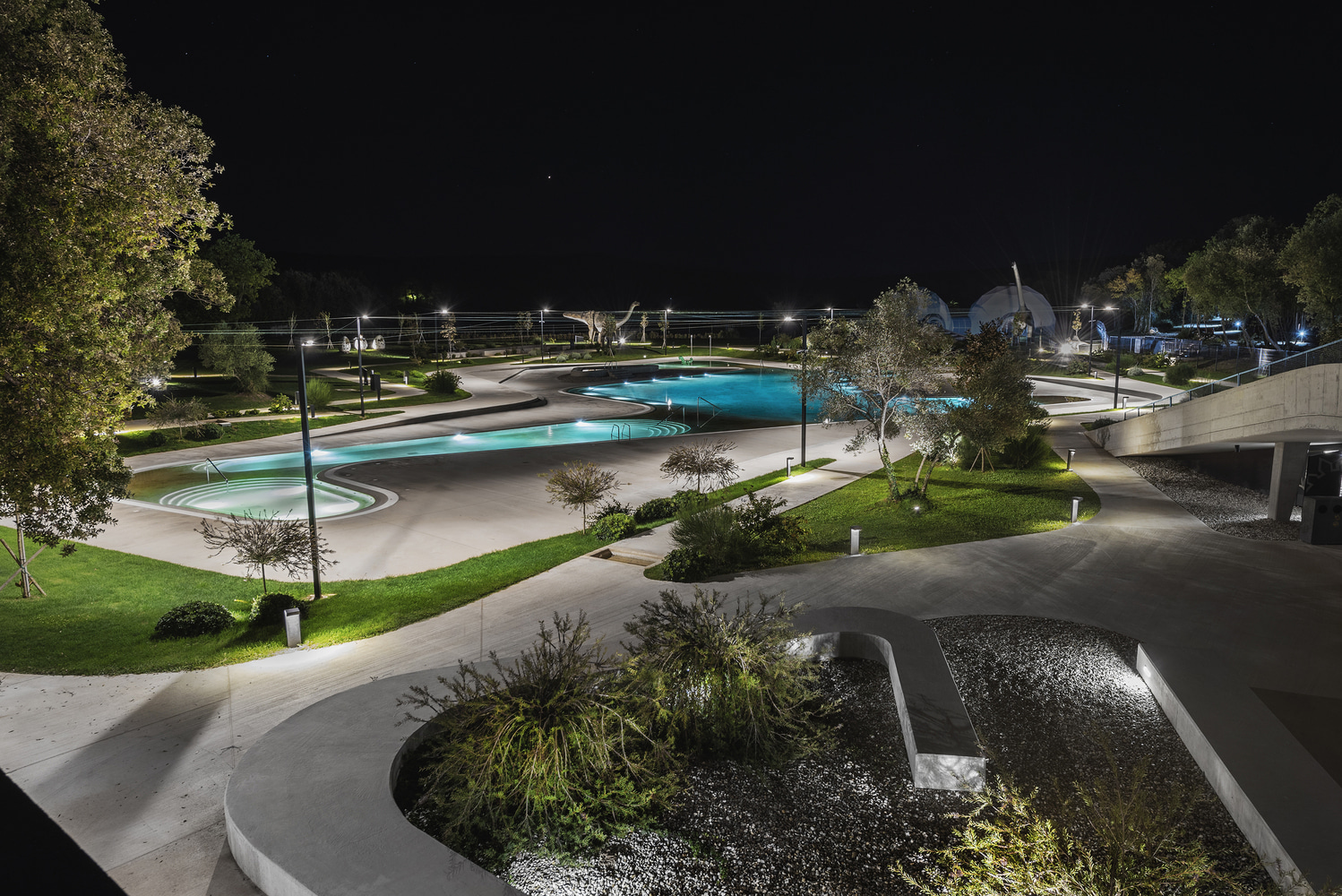 Image by Bosnić+Dorotić / archdaily.com
Image by Bosnić+Dorotić / archdaily.com
This is not the first time that a building in Bale is nominated for a prestigious award. In 2008, a sports hall designed by the architectural studio 3LHD won first place in the sports structures category at the World Festival of Architecture in Barcelona. Impressive in itself, but even more so given that Bale won against the Wembley Stadium in London, a €1,1 billion investment - almost 1,000 times more than the Bale hall. Watercube Olympic Pool and Beijing Tennis Centre were also shortlisted in the same category that year.
Last week, the Mon Perin company that runs the camp of the same name announced they will be investing 100,000 euro in archaeological research at the Kazamate site in San Polo Bay, to be carried out by the specialised company In Situ. Namely, it is an ancient Roman villa rustica, a structure dating to the period between the 1st and the 4th century. The villa is to be granted the status of a protected cultural site.
Krk Island Determined to Become Europe’s First Zero Waste Island
February 8th, 2022 - Krk island is on its way to officially join the list of some five hundred European cities and municipalities that have implemented the international Zero Waste strategy
The management of Ponikve, the main utility company on Krk island, recently met with representatives of Zelena akcija (Green Action), an organisation which is working on implementation of the zero waste strategy in Croatia.
Experts of Zelena akcija analysed the waste management system of Krk island and considered which tasks Krk has yet to fulfill in order to position and brand itself as the first zero waste island in the European Union. They discussed this with Ponikve director Neven Hržić and assistant director Ivan Jurešić, reports Novi list/Mladen Trinajstić.
Waste sorting on Krk already has a 60 percent share in overall waste management, according to Jurešić. The population of the biggest Kvarner island has no intention of stopping there, instead planning to achieve even more ambitious goals.
‘Our cooperation with the organisation [Zelena akcija] is part of the project "Transitioning to zero waste Europe, one community at a time", which, as you might remember, our utility company, or rather the island of Krk, joined last year in July when we signed the decision for Krk to adopt the international zero waste strategy’, said Jurešić.
At the meeting, the parties discussed and agreed upon further steps in the implementation of the zero waste model of maximum reduction of waste, as well as reuse and recycling.
‘The recently held meeting gave us an opportunity to go over and agree on some new, additional measures and activities that we will jointly work on in the coming years, all with the aim of meeting the demanding parameters required for the official inclusion of our island in this prestigious European ecological list’, said Jurešić for Novi list.
Among the agreed goals is a reduction of mixed waste generated by the island’s population - including tourists - from 235kg per person (2019) to 150kg per person annually. They also plan for separate waste collection to reach a 70 percent share in overall waste management.
They have also agreed on certain steps to achieve better use of biodegradable waste, and are planning to establish a so-called Centre for Reuse, a facility where prematurely discarded items will be given a new life.
In order to meet these goals, the Ponikve company will work to improve the method of separate waste collection, charge for collection based on the amount of generated mixed waste, increase home composting, open the mentioned centre for reuse, and introduce numerous models to reduce waste generated on the island, all in the coming years.
Representatives of Zelena akcija consider all the proposed measures feasible, and the agreed goals achievable. They fully expect the local self-government on Krk to meet the set criteria for a zero waste certification.
‘We are pleased with the successful cooperation with the local authorities on Krk island, as they are among the few in our country to have met the goal of separate waste collection in the share of 50 percent by the end of 2020. In cooperation with us they set even more ambitious goals and measures that will help them secure a better quality of life for the island inhabitants, but also put Krk island on the European map of the most successful local communities when it comes to sustainable waste management’, said representatives of Zelena akcija in a statement after the meeting.
‘Superstitious and Debauched’: Impressions of Croatia in Travel Journals of Yore (III)
February 8th, 2022 - In the third and final part of our series, our travellers explore the Kvarner area, discovering bura wind, scampi, and wellness
In our last feature on travel journals documenting trips to the Adriatic, we left off in southern Dalmatia. And now, where our travellers would depart for Montenegro, we’ll circle back to the Northern Adriatic instead. This time, we’re tagging along with A. Fortis (1770s) and G. Marcotti (1890s) - see Part I and Part II for more info and some impressions of Istria and Dalmatia.
Why go back? A good few places were left out of both previous pieces for the sake of brevity, so we’re making this a trilogy to see what our protagonists thought about the Kvarner gulf. It’s a detour alright, but in the words of Fortis who expressed a similar sentiment in one of his letters:
It is a massive geographical leap to move from the island of Brač straight to the island of Rab which is one hundred and twenty miles away. But what can I tell you?
Exactly. But before we get to Rab and other Kvarner islands, let's make a stop in Senj. It’s a coastal town best known for the magnificent Nehaj fortress, a historic stronghold of Uskoks who kept invaders at bay. Fortis says:
A very famous city in the history of the Venetian Republic which had to formally wage a war against it and, being unable to conquer it for a long time, suffered heavy losses in its possessions in Istria and Dalmatia; it was a subject of interest for a Venetian traveller. I wanted to meet the descendants of those fierce Uskoks who were admired for their courage and hated for their cruelty.
I wish I could learn their history as penned by one of them, but Uskoks fought heroically and dealt in ransom and loot collection, and did not write historical accounts.
You don’t say.
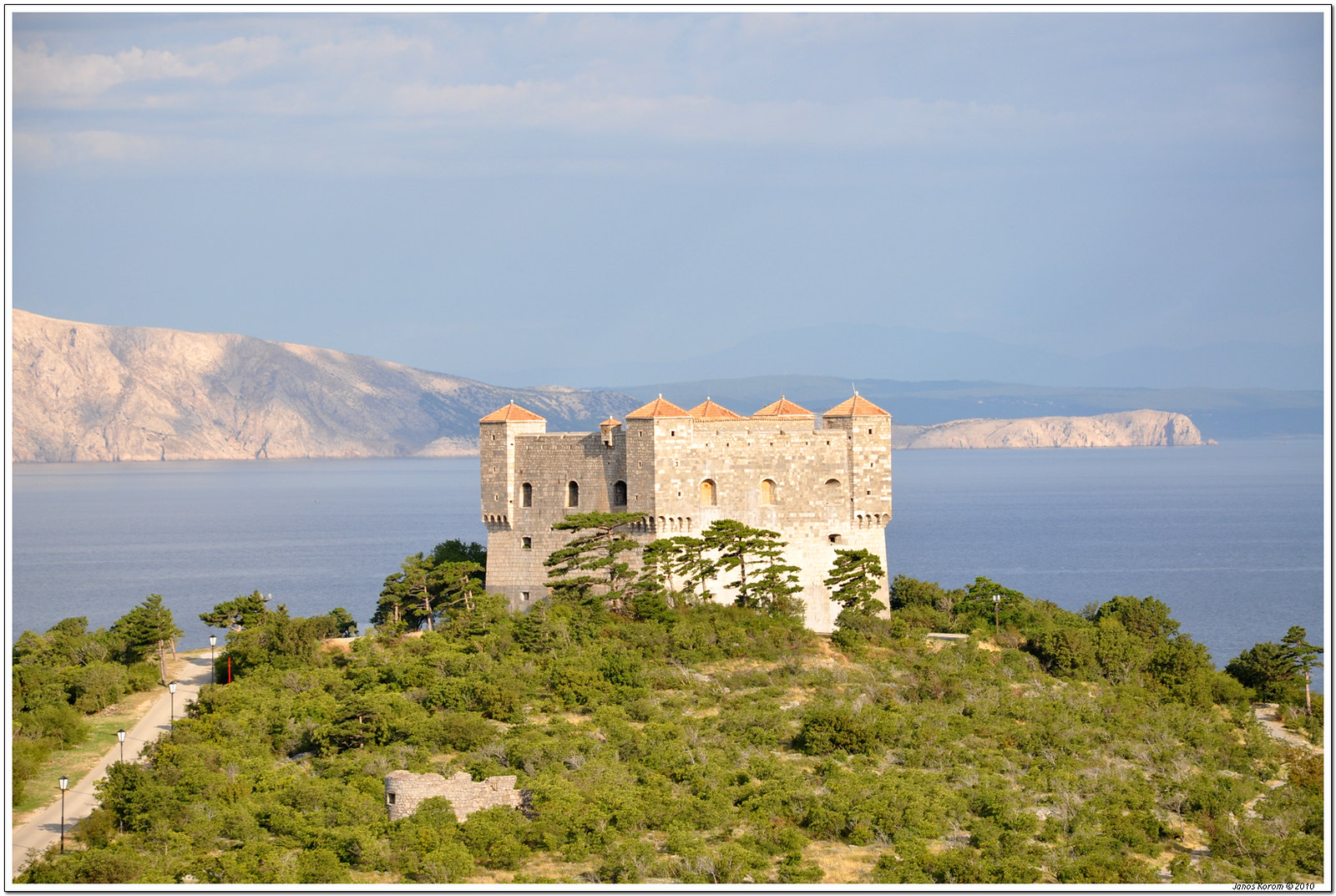 Nehaj fortress / János Korom / Flickr
Nehaj fortress / János Korom / Flickr
With Senj ruled by Austria at the time, the Uskoks truly were a source of headache for Venice; they defended the city, but also plundered Venetian galleys along with most other commercial ships in the area. Their conquests had a blessing of the local clergy, monasteries received a tithe from the bounty, and so the 16th-century Senj essentially thrived on piracy and looting. It's not a surprise then that its population might've seemed a bit, uh, laid-back to an outsider:
The people of Senj are superstitious and debauched at the same time. The women of this city are said to be prone to love affairs; they are easy-going and in this regard do not bear a resemblance to Croatian women.
Uh-oh. Shall we proceed with caution? Luckily, instead of lamenting loose morals, Fortis turns this into social commentary:
And so romantic adventures are frequent, and sometimes followed by unpleasant consequences. The bishop and the monastery heads who make up the court that deals with these matters issued a decree a few years ago, stipulating that if an unmarried woman were to give birth to a child, she could not sue her lover in court for marriage or possessions. This cruel ordinance led to an even greater decline of morals, and every year, many unfortunate girls are sacrificed to disgrace for which there is no cure; it is heartless and outrageous barbarism.
A progressive stance for the 1770s.
To finish, a few of his thoughts on the infamous Senj bura:
The wind coming from the barren mountains blows so fiercely in that narrow gap, there are times in winter when one cannot leave the house without peril, and it is even worse outside the city. Even when they do not walk across the square where no sensible person would appear at such times, but through the narrow winding alleys, it often happens that children and frail folk are lifted from the ground and slammed against the wall by the wind. When an urgent need compels someone to go to the docks where ships are anchored, despite crawling on their hands and knees they sometimes roll away like a straw because of the force of the wind.
Senj bura hasn’t lost any of its force to this day, and Fortis was wise not to take it lightly.
***
Now, to Rab. Those who read the first part of this series might recall his unabashed trashing of the poor populace of Pag island, and it would appear that Fortis really held a grudge against island folk in general:
The island of Rab would have everything needed to support its small population, if only its agriculture was in the hands of less stupid and lazy people.
He continues:
Nevertheless, [the island] produces firewood, shipped off to Venice on the backs of numerous donkeys each year, as well as grain, oil, excellent wine, brandy, and since the ancient times - silk, the silkworms feeding on black mulberry leaves. Exported are also leather, wool, sheep, pigs and horses of good breed.
I don’t know, they don’t sound that lazy to me. There’s more:
The sea is beginning to be of use, with salt pans maintained on the island that give an abundance of good fine salt. In addition, in spite of fishing being carried out here in a very poor and sloppy manner, the catch of tuna, mackerel and sardines is an important item in the trade of the people of Rab who (as the rest of Dalmatia) prefer to sell their goods to foreigners rather than Venetians. Despite all these natural products, the island is far from being rich or achieving adequate progress, as uncultivated land and idle peasants are too commonly seen.
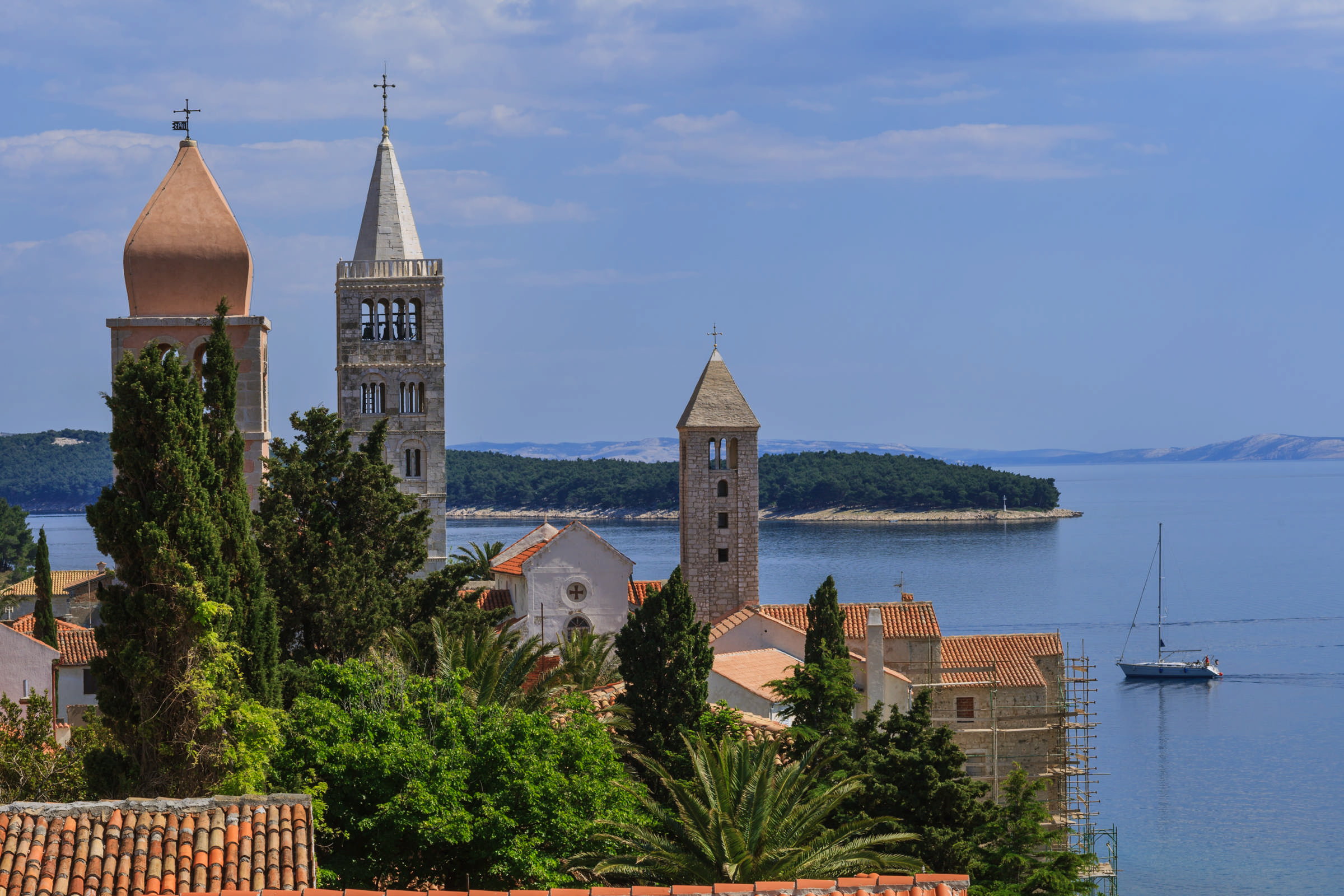 Rab town by Romulic and Stojcic
Rab town by Romulic and Stojcic
And an anecdote:
In the past, there was a bishop of Rab named Ottavio Spaderi; it occurred to him not to allow on the feast of St. Christopher for his relics to be displayed for public veneration, seeing as he doubted their authenticity. The folk rebelled, wanting to throw him into the sea from the top of the hill on which the cathedral stands, and the riots did not subside even after the moment had passed. The government had to send a warship to save the prelate from peril, and the pope considered it his duty to grant him a more submissive congregation in Italy.
Feisty. Fortis is lucky he wasn’t thrown from a cliff as well.
***
Later on, Marcotti writes about what you can find on Lošinj island:
A hunters’ association, a branch of the tourist club, a company for afforestation and landscaping. (...) There is no shortage of foreigners: Mali Lošinj has the Vindobona hotel, three special trattorias, five boarding houses. There are two other guesthouses and a resort for convalescent children in Veli Lošinj.
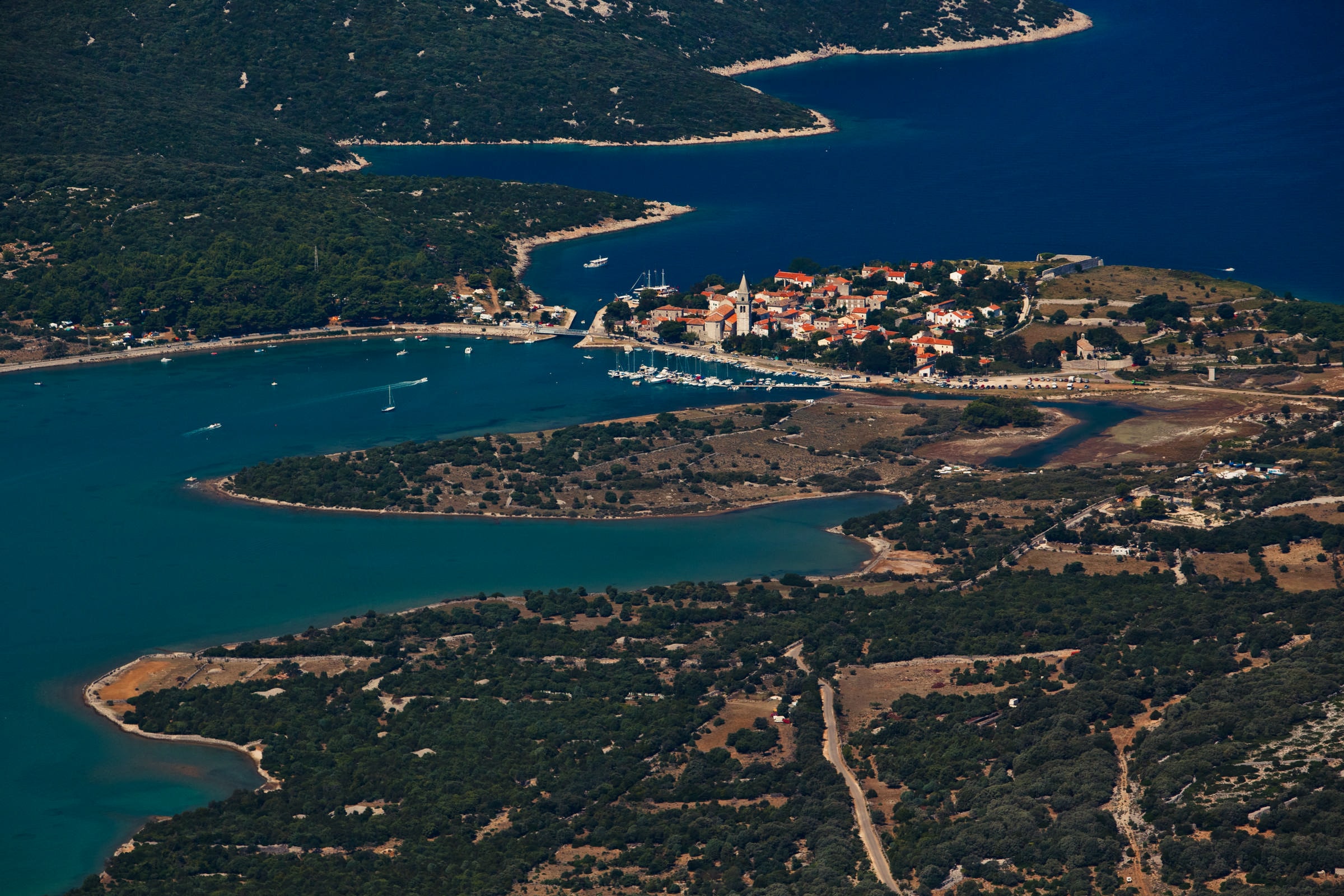 Osor town on Cres island by Romulic and Stojcic
Osor town on Cres island by Romulic and Stojcic
Visiting Cres island, he notes:
Generally speaking, sheep herding is difficult on islands of Kvarner due to bura; large juniper trees, grown and naturally shaped into canopies by the frequent pressure of the wind, provide shelter to roaming flocks.
***
On to Rijeka, the biggest town in the Kvarner gulf, visited by both our travellers. Fortis first:
Croatian is the native language. Refined folk of both sexes speak good Italian, imitating the Tuscan manner of speaking; surely they should be praised much more than us who butcher our beautiful language but mock everyone else who endeavours to speak it unless they are born in Tuscany.
The people of Rijeka are mild-mannered, and their company jovial, though marked by moderation.
Marcotti also spends some time in Rijeka and doesn’t let us down. Two of the most important things in any destination: where to eat and how to get around!
Numerous trattorias as well as those operating as part of hotels; breweries of the leading Austrian factories. Scampi are delicious, especially served in risotto. [There are] car services, omnibuses, public valets.
…that last one being a somewhat loose translation, referring to a particular profession: a person stationed in a public place ready to help you with any given need or errand. Think a concierge, a tourist guide, a messenger, a personal shopper, a delivery service, all rolled into one. Looking for directions to a certain place or perhaps need a hand with those shopping bags? The public valet’s got your back.
 Rijeka by Romulic and Stojcic
Rijeka by Romulic and Stojcic
He goes on:
The look of the city is really nice, its architecture Italian in character, though it offers little of note when it comes to art.
Ah well, you win some, you lose some. At least there are good scampi.
And for a final thought, a line used time and time again, a variation of which is probably currently displayed somewhere on the pages of the local tourist board:
The panoramic view of Rijeka and the Kvarner gulf as seen from Trsat is truly magnificent.
***
Opatija has grown into a fully fledged tourist destination by this point (late 1890s), and a health resort at that. Marcotti reports:
There’s a good number of nonagenarians in perfect health living on this riviera.
Its most sheltered and most pleasant place, Opatija, is advertised by the Südbahn company (Southern Austrian railways) as a health resort for the winter and sea-bathing in the summer. It has developed formidably and can barely accommodate the large clientele that flocks to it, particularly those from Austria-Hungary and Germany.
The entire facility cost the Südbahn no less than 3 million florins. There are milk, honey and egg treatments, massage, gymnastics, and walks for health.
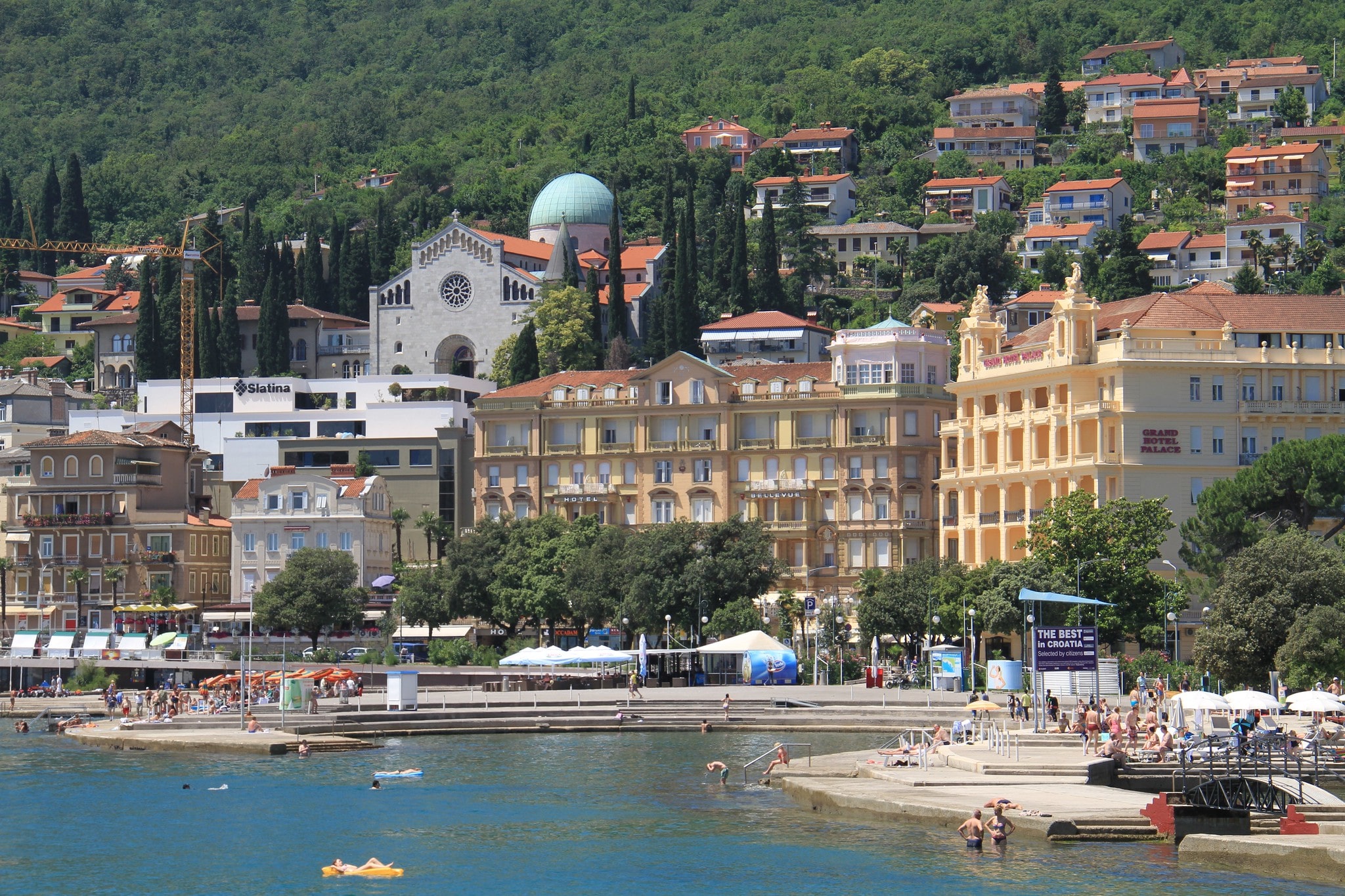 Opatija by Ronnie Macdonald / Flickr
Opatija by Ronnie Macdonald / Flickr
Some interesting insight into the early days of wellness, followed by a short recap showing just how quickly Opatija gained a reputation as a place to be:
Starting from 1885 (when Archduke Rudolf and his wife Stéfanie stayed here for the first time) visiting and staying in Opatija has become a pastime of high regard, very fashionable in court circles and among aristocrats and diplomats. This is from the 15th of October to the 15th of May: in the other five months, the bourgeois society visits for sea bathing. Empress of Austria, many archdukes and archduchesses, the royals of Serbia and Romania were some of Opatija’s guests.
***
With tourism becoming an industry, this seems like a good place to end this feature. Admittedly, when it comes to travel journals that paint a picture of the Croatian coast in earlier times, we’ve barely scratched the surface in our three-part series. Countless travellers have chronicled their Adriatic adventures, and providing you have time and the resolve to peruse old texts, it’s a fascinating body of work to study. We kept the scope small not to turn this into a dissertation, but hope you’ve enjoyed our travellers’ reviews anyway. Just keep in mind these are opinions of individuals from centuries past, and not neccessarily an actual representation of what Croatia is like - lazy folk, loose morals and local superstitions included.
Sources for Part III:
Giuseppe Marcotti, L’Adriatico Orientale, da Venezia a Corfu (1899)
Alberto Fortis, Viaggio a Dalmazia, 1774 (Croatian edition: Put po Dalmaciji, Globus, Zagreb, 1984)
Central Bank to Hold New Competition for Design of €1 Coin With Marten Motif
ZAGREB, 8 Feb 2022 - The Croatian National Bank (HNB) said on Tuesday that in the coming days its Currency Committee would invite new proposals for the design of the national side of the €1 coin with the marten as the motif.
The HNB said that late on 6 February, the Currency Committee, as the expert body of the HNB Council in charge of the competition for the designs of the national side of euro coins, received a statement from Stjepan Pranjković whereby he withdrew his design for the marten motif and waived all rights stemming from having participated in the competition.
Today, the Currency Committee accepted Pranjković's decision and, in order to eliminate any further uncertainty, suspicion or doubt concerning the selection of the design for the marten motif, decided to invite new proposals for the design.
The HNB said that during the competition all authors were required to sign statements whereby they confirmed that their designs were original intellectual creations made solely for the needs of the competition.
The new competition for the design of the back of the €1 coin with the marten motif will not bring into question the timely manufacture of Croatian euro coins, the HNB said.
The selected designs for the national side of euro and cent coins were presented last Friday, including the marten motif for the €1 coin by Pranjković, who has a master's degree in applied arts.
Shortly thereafter, however, media reported that his design was almost identical to a marten photo by Scottish photographer Iain H. Leach, which raised the question of intellectual property infringement.
In a letter to the HNB Currency Committee on 6 February, Pranjković said that, "spurred by the unpleasant atmosphere in the media and on social networks as well as the pressures" he was exposed to, he had decided to withdraw his design for the €1 coin with the marten motif as well as waive all rights stemming from having participated in the design competition.
Croatia Logs 5,545 New COVID Cases, 50 Deaths
ZAGREB, 8 Feb 2022 - In the last 24 hours 5,545 new coronavirus cases, out of 13,669 tests, and 50 related deaths have been registered in Croatia, the national COVID-19 crisis management team said on Tuesday.
There are 43,467 active cases, including 2,229 hospitalised patients, of whom 182 are on ventilators, while 19,966 persons are self-isolating.
To date, Croatia has registered 990,595 coronavirus cases, 14,244 related deaths, and 56.65% of the total population has been vaccinated, i.e. 67.40% of adults, of whom 65.05% fully.


